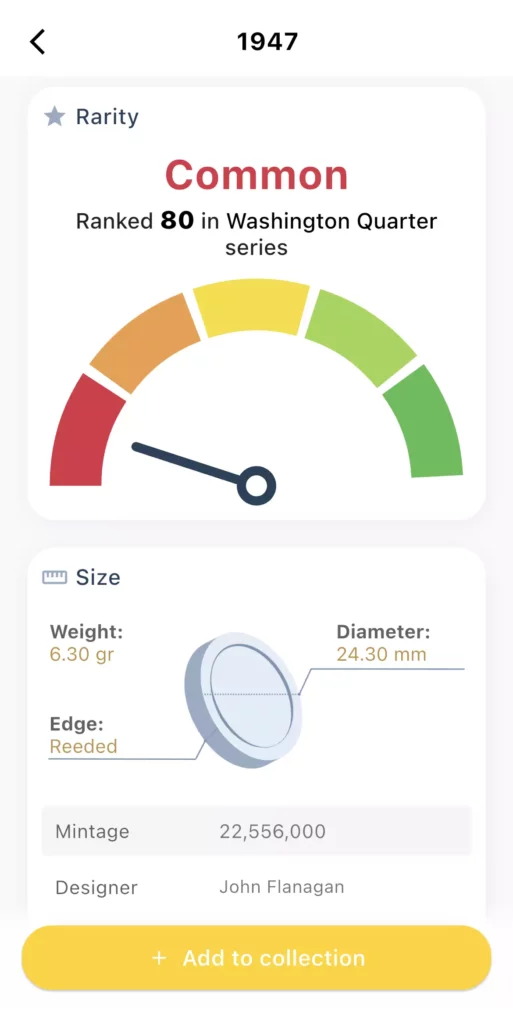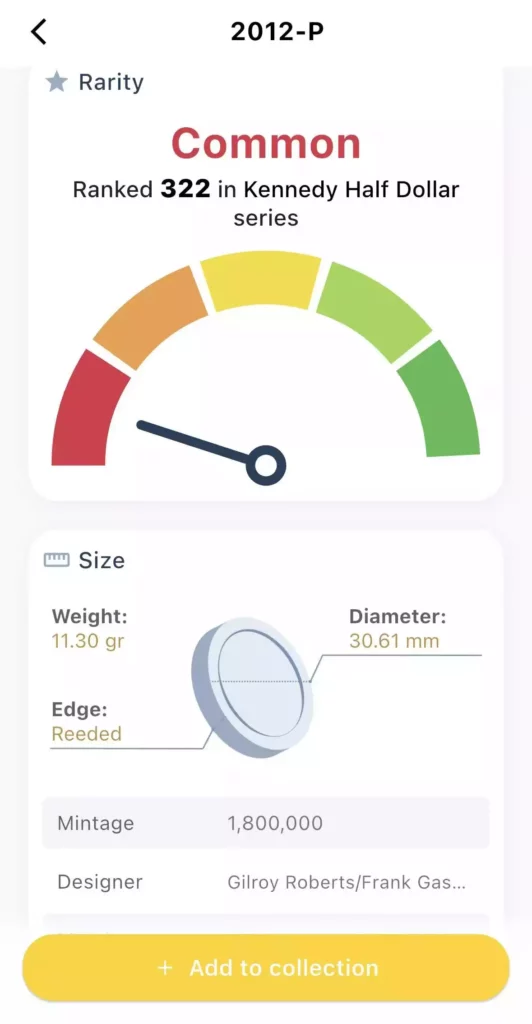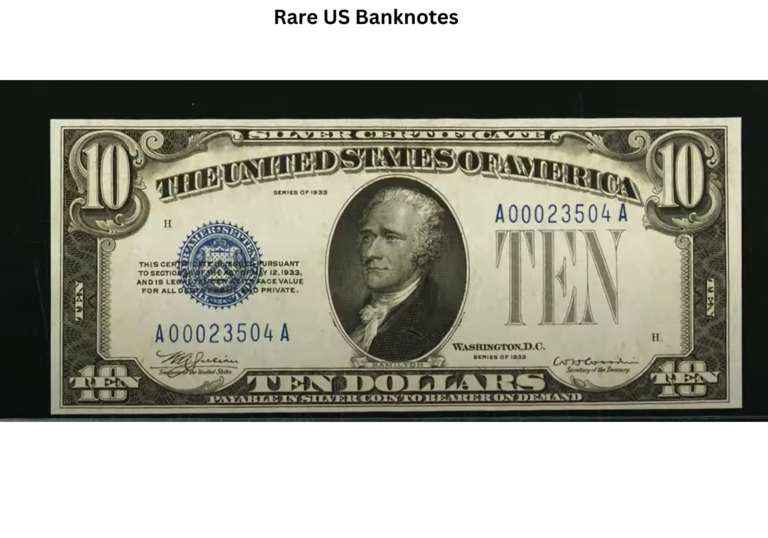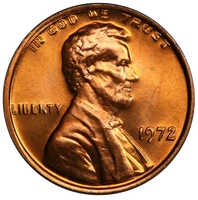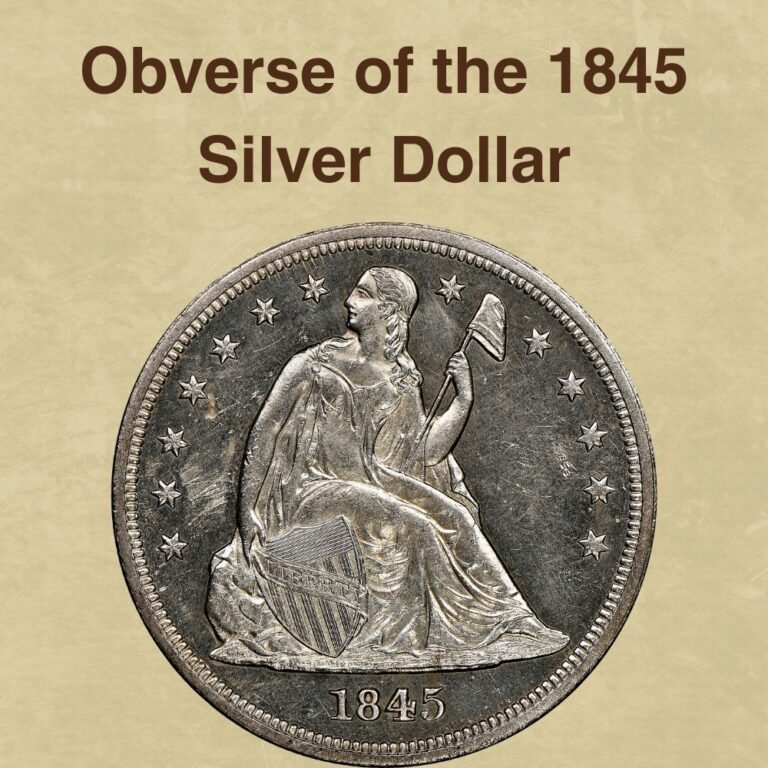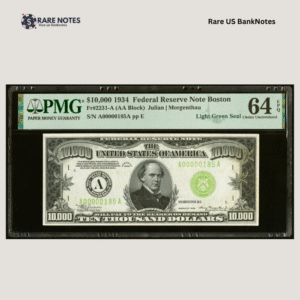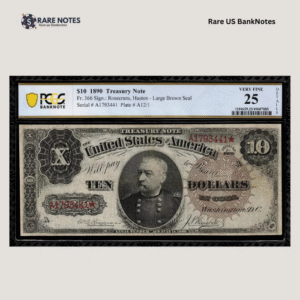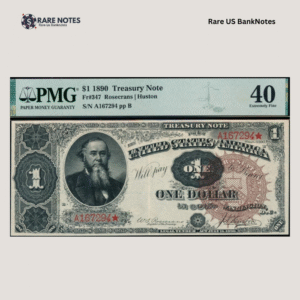Still holding onto that 1947 quarter? Smart move—but probably not for the reasons you think.
While everyone obsesses over rare dates and mint errors, the 1947 quarter market tells a different story. We crunched the numbers on thousands of recent transactions and found that conventional wisdom about these coins is mostly wrong. The quarters selling for real money aren’t always the ones you’d expect.
Here’s what the data actually shows about 1947 quarter values—and why some common-looking coins are quietly selling for hundreds while “rare” ones sit unsold.
1947 Quarter Value By Variety
Here’s the current market data for all 1947 quarter varieties—Philadelphia (no mint mark), Denver (D), San Francisco (S), and the special Proof-Like (PL) edition—showing values across every grade from Good to Mint State.
1947 Quarter Value Chart
| TYPE | GOOD | FINE | AU | MS | PR |
|---|---|---|---|---|---|
| 1947 No Mint Mark Quarter Value | $6 | $6 | $7 | $1,632 | — |
| 1947 D Quarter Value | $6 | $6 | $7 | $1,202 | — |
| 1947 S Quarter Value | $6 | $6 | $7 | $465 | — |
| 1947 S PL Quarter Value | — | — | — | $171 | — |
Tip: Use our CoinValueChecker App for real-time variety identification and current market values.
1947 Quarter Market Trend
Market Interest Trend Chart – 1947 Quarter
The decade-long market interest trend for 1947 quarters reveals a fascinating boom-and-bust pattern that most collectors miss.
From 2015 to 2018, we see dramatic volatility with multiple peaks—classic signs of speculative interest. The early 2016 spike represents the highest point in the entire decade, followed by another significant surge in 2017. Then came the crash. By 2019, interest plummeted to near-bottom levels, wiping out the speculators and leaving only serious collectors.
Here’s where it gets interesting: since 2020, the market has stabilized at much lower levels with gentle fluctuations. No more wild swings, no more hype cycles—just steady, sustainable interest. This pattern suggests 1947 quarters have finally found their true market equilibrium after years of artificial inflation.
The recent uptick in 2024-2025 hints at renewed collector interest, but nothing like the frenzied peaks of the past. This mature, stable pattern is actually healthy for long-term collectors who prefer predictable markets over roller-coaster speculation.
Want to see how 1947 quarters stack up against other dates? Check out the US Coin Market Trend Ranking (Top 100) to discover which coins are actually gaining momentum.
History of the 1947 Quarter
The 1947 quarter emerged during a unique transitional period in American history. As the nation shifted from wartime production to peacetime prosperity, the U.S. Mint faced unprecedented demand for coinage to support the booming post-war economy.
Production numbers tell the story: Philadelphia struck 22,556,000 quarters, Denver added 15,338,400, and San Francisco contributed 5,532,000.
These substantial mintages reflected the economic expansion as returning veterans entered the workforce and consumer spending surged after years of wartime rationing.
The design remained unchanged from John Flanagan’s original 1932 creation, featuring Washington’s profile on the obverse and the heraldic eagle on the reverse. However, 1947 quarters show subtle production variations that keen collectors appreciate today.
Strike quality varied considerably between mints, with San Francisco generally producing the sharpest examples despite having the lowest mintage.
An interesting footnote: some 1947-S quarters exhibit proof-like characteristics with mirror-like fields and sharp details, though they weren’t intentionally struck as proofs. These special pieces, now cataloged as “S PL” varieties, likely resulted from fresh dies or specially prepared planchets early in production runs.
Their discovery decades later added a new collecting dimension to what many considered a common date, proving that even well-studied coins can still surprise us.
Is Your 1947 Quarter Rare?
1947 No Mint Mark Quarter
1947-D Quarter
1947-S Quarter
1947-S PL Quarter
The rarity scores for 1947 quarters reveal an unexpected twist in conventional collecting wisdom. Despite Philadelphia having the highest mintage at 22.5 million, it scores 29 and ranks 80th—actually rarer than Denver’s 15.3 million mintage, which scores only 27 and ranks 112th. San Francisco, with the lowest regular mintage at 5.5 million, scores 26 and ranks 124th.
The real surprise? The 1947-S Proof-Like variety, discovered years after minting, scores just 12 and ranks 305th as “Common.” This counterintuitive ranking shows that mintage numbers don’t always predict rarity—factors like hoarding, melting, and regional distribution play bigger roles.
Want to check your own quarters? The CoinValueChecker App instantly identifies rarity scores with a quick photo scan.

These mid-range rarity scores make 1947 quarters perfect for intermediate collectors—scarce enough to be interesting, but not so rare as to be unobtainable. Curious about truly rare dates? Explore the complete Washington Quarter Key Dates (Rarity Ranking) to see which years top the scarcity charts.
Key Features of the 1947 Quarter
The 1947 Washington quarter represents post-war American coinage, struck during the economic boom following World War II. These quarters maintained John Flanagan’s iconic design that had been in circulation since 1932, serving a nation transitioning from wartime to peacetime prosperity.
The Obverse of The 1947 Quarter

The obverse features Washington’s left-facing profile with LIBERTY arcing above and “IN GOD WE TRUST” to the left of his neck. Flanagan’s initials “JF” appear at the base of the neck truncation, while the date “1947” sits prominently at the bottom. This clean, dignified design had become a familiar sight in American commerce.
The Reverse of The 1947 Quarter
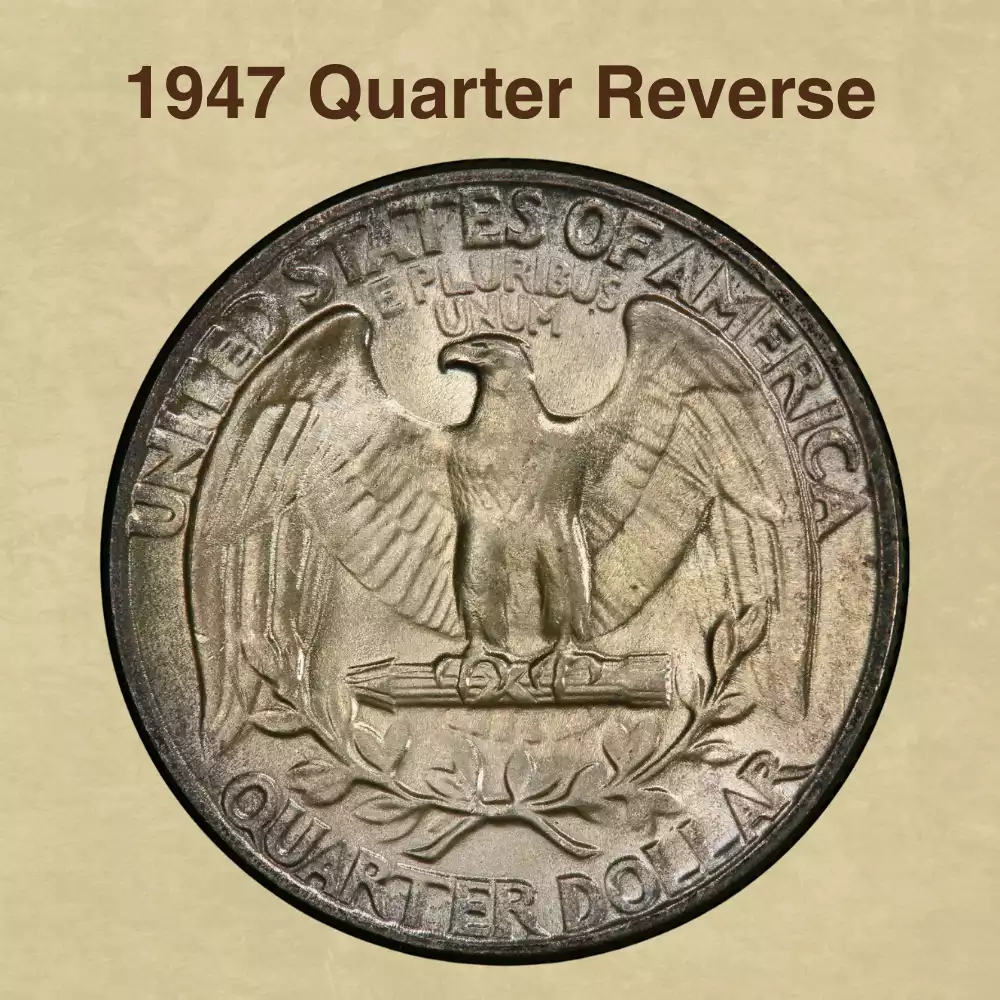
The reverse displays a heraldic eagle with spread wings, clutching 13 arrows symbolizing the original colonies. An olive branch beneath represents peace—particularly meaningful in the post-war era. “UNITED STATES OF AMERICA” and “E PLURIBUS UNUM” arc above, with “QUARTER DOLLAR” below. Mint marks (D or S) appear beneath the olive branch center.
Other Features of The 1947 Quarter
The 1947 quarter contains 90% silver and 10% copper, weighing 6.25 grams with 0.18084 troy ounces of pure silver. Specifications include a 24.3 mm diameter, reeded edge with 119 reeds, and 1.75 mm thickness. Notably, some 1947-S quarters exhibit proof-like characteristics with mirror fields, though they weren’t officially issued as proofs—these special strikes are now highly prized by collectors.
1947 Quarter Mintage & Survival Data
1947 Quarter Mintage & Survival Chart
Survival Distribution
| Type | Mintage | Survival | Survival Rate |
|---|---|---|---|
| No Mint | 22,556,000 | 2,255,000 | 9.9973% |
| D | 15,338,400 | 1,533,000 | 9.9945% |
| S | 5,532,000 | 553,000 | 9.9964% |
The 1947 quarter mintage data shows typical post-war production levels: Philadelphia led with 22.5 million, Denver followed with 15.3 million, and San Francisco produced 5.5 million. Combined, over 43 million quarters entered circulation to support the booming economy.
What’s remarkable is the survival rate—all three mints show nearly identical preservation at 9.99%, meaning roughly 90% of 1947 quarters have been lost to silver melting or heavy circulation. This translates to approximately 4.3 million surviving examples today, distributed proportionally to original mintages.
The consistency across all mints suggests no particular variety was preferentially saved or melted. Unlike earlier dates where collectors hoarded low-mintage coins, the 1947 quarters faced uniform attrition. This 10% survival rate is actually higher than many silver quarters from the 1950s-1960s, likely because some were saved as birth year gifts during the post-war baby boom.
Want to see how 1947 survival rates compare to other years? Explore the Washington Quarter Survival Ranking (Top 100) to discover which dates beat the odds.
1947 Quarter Grading
Grading 1947 quarters requires attention to key wear points that separate a $6 coin from a $1,600 gem. Start with Washington’s hair—the waves above his ear lose definition first, blending together in lower grades. Check the eagle’s breast feathers on the reverse; in Mint State examples, you’ll see complete feather separation and crisp wing details.
The jump from AU-58 to MS-60 is crucial for 1947 quarters. Even the slightest friction on Washington’s cheek or the eagle’s breast drops the coin into AU territory, cutting value by 90% or more.
Want instant grading assistance? The CoinValueChecker App analyzes wear patterns through AI technology, providing accurate grade estimates from a simple photo.

For Mint State coins, focus on luster quality and contact marks. The difference between MS-63 and MS-65 often comes down to the number and placement of bag marks—especially critical for 1947-S quarters where MS-65 examples bring significantly more than MS-63s.
Master the nuances of grading with our comprehensive guide: How to Grade Washington Quarters.
1947 Quarter Value Guides
Each 1947 quarter variety offers unique collecting opportunities—from the common Philadelphia strikes to the scarce Proof-Like specimens discovered years after minting.
- 1947 No Mint Mark(Philadelphia)
- 1947-D (Denver)
- 1947-S (San Francisco)
- 1947-S PL (San Francisco)
The 1947 quarter series presents an interesting value hierarchy. While Philadelphia produced the most coins, and San Francisco the least, mintage doesn’t directly correlate with value in lower grades—all three regular strikes trade near silver melt value when worn. The real premiums emerge in Mint State grades, where subtle differences in strike quality and preservation separate $100 coins from $1,000+ examples. The Proof-Like variety stands apart as a special discovery that combines the lowest “mintage” with unique mirror-like surfaces.
1947 No Mint Mark Quarter Value

The 1947 Philadelphia quarter stands out as a transitional piece in American numismatics. Struck just two years after World War II ended, these quarters served a nation experiencing unprecedented economic growth and consumer demand. What makes them particularly interesting is their dual nature—common enough in circulated grades to be affordable, yet surprisingly scarce in top Mint State conditions.
The sharp contrast in values between MS-65 and MS-67 grades reflects the challenge of finding well-preserved examples from a time when coin collecting was less popular than today.
1947 No Mint Mark Quarter Price/Grade Chart
Price by 1-70 Grade (Latest Auction Records Included)


